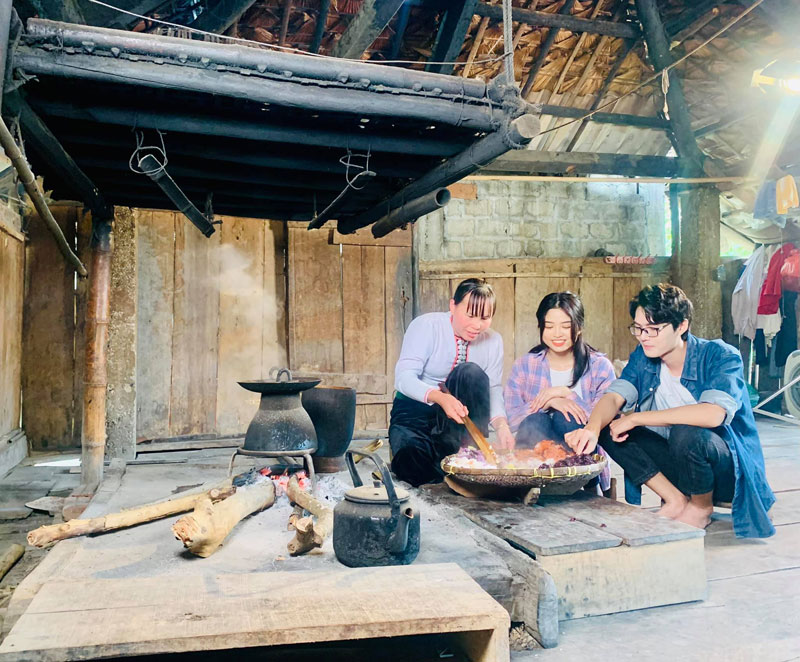


 Muong ethnic people
in Da Bia community tourism - now it is Duc Phong hamlet (Da Bac) are preparing
a traditional leaf food tray for visitors to enjoy the culinary culture of
Muong.
Muong ethnic people
in Da Bia community tourism - now it is Duc Phong hamlet (Da Bac) are preparing
a traditional leaf food tray for visitors to enjoy the culinary culture of
Muong.
Mr. Farley says: During my stay in Sung hamlet, besides admiring the hundred-year-old Tro tree, discovering Sung cave, experiencing San Tuyet tea picking on Bieu mountain, I really like the feeling of eating, staying and living in homestays. The homestay owners are very friendly, and ready to help us to experience the traditional dishes made by the local people. I especially remember the meals with the national flavors and deliciousness prepared by the owner for the guests such as: Hoang wine, our pickled meat, black sticky-rice cakes or simple and rustic dishes like bamboo shoots from the forest, pumpkin soup red, tofu sauce ...
At the community tourism sites of Muong ethnic people living along the lake such as Ngoi hamlet in Suoi Hoa commune (Tan Lac), Giang Mo village in Binh Thanh commune (Cao Phong), Ke hamlet in Hien Luong commune, Mo Hao, Duc Phong in Tien Phong commune (Da Bac), homestays often include the eating - sleeping – resting services while tourists stay at the community tourism villages. Visitors coming to the hamlets and villages are also an opportunity for the households to introduce and treat the traditional dishes with flavors of the ethnic minority cuisine. For the people of Muong villages, the dish contains the heart and shows the hospitality. The indispensable cuisine is grilled stream fish that is both sweet and crispy, the grilled chicken, the grilled Muong pork, or the steamed vegetable, the wild bamboo shoots, the sour meat ...
Ms. Dinh Thi Hao, the Director of Da Bac Community Tourism joint Stock Company, says: Besides the beauty of the immense, poetic banks of Da River, the culture of Muong culinary with special dishes is one of the attractions grabbing visitors' feet. Coming to the tourism in the lake area, visitors will forever remember the flavor of the diversifying culinary made from the local agricultural products and the typical products of the lake area. Here, visitors will enjoy dishes made from shrimp, fish raised on the lake area of Da River, the fresh and clean dishes in mountainous areas such as pigs, chickens raised by the local people... Muong cuisine has really attracted many groups of Western tourists and domestic groups to join tours, routes to explore, experience tourism in the Northwest.
Currently, when capturing the psychology, as well as the needs of tourists staying at the community tourism sites in the lake area, many institutions operating in the community tourism sector have been actively training the skills to develop community tourism, participating in cooking classes, experiencing how to make traditional dishes from locally available food sources in combination with the modern culinary processing methods. Some tourism villages have set up a culinary team, specializing in cooking to serve guests such as in Sung village in Cao Son commune, Da Bia in Tien Phong (Da Bac), Giang Mo village in Binh Thanh commune (Cao Phong). Thereby, it has been contributing to improving the service quality, attracting domestic tourists to visit, travel, stay and relax. At the same time, it has been contributing to building the brand, promoting the the image and culture of the ethnic groups in Hoa Binh lake area.